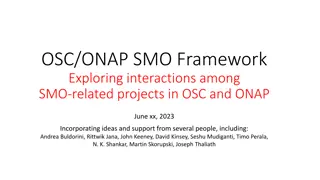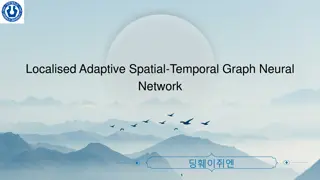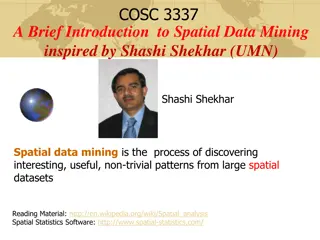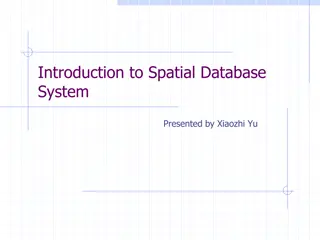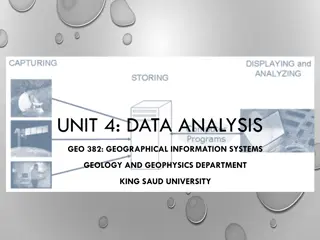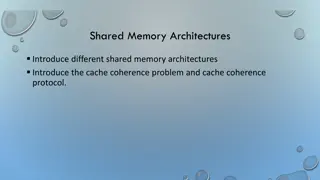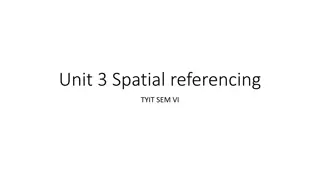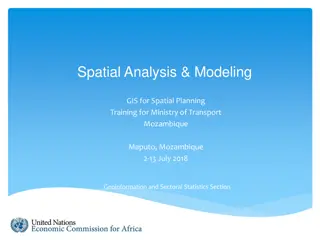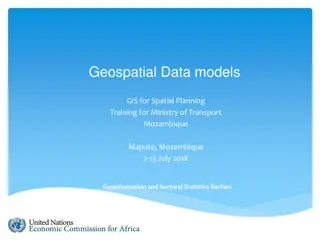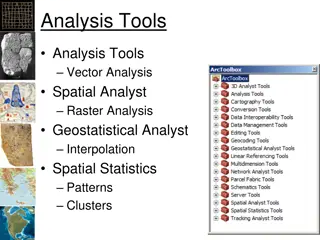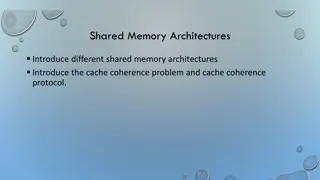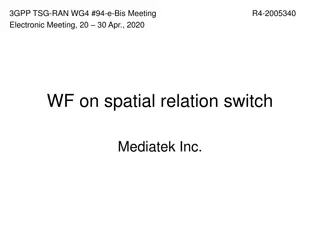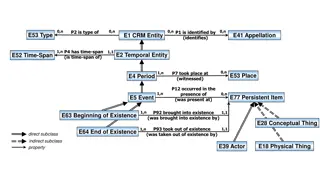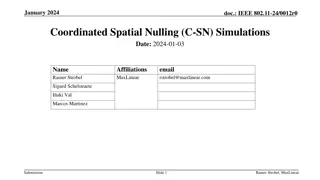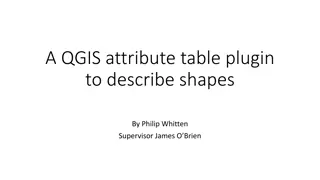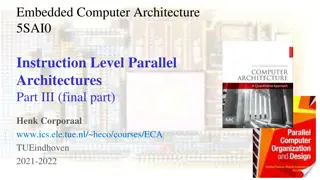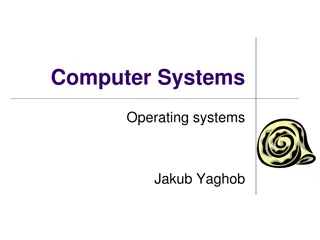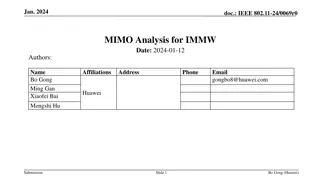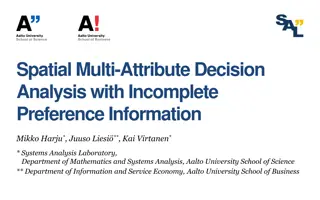Decoupled Spatial Architectures Hands-on Exercises
Decoupled spatial architectures through hands-on exercises and advanced programming techniques. Learn how to add new instruction capabilities to spatial processing elements, integrate instructions, and enhance the functionality of spatial PEs
Download Presentation

Please find below an Image/Link to download the presentation.
The content on the website is provided AS IS for your information and personal use only. It may not be sold, licensed, or shared on other websites without obtaining consent from the author.If you encounter any issues during the download, it is possible that the publisher has removed the file from their server.
You are allowed to download the files provided on this website for personal or commercial use, subject to the condition that they are used lawfully. All files are the property of their respective owners.
The content on the website is provided AS IS for your information and personal use only. It may not be sold, licensed, or shared on other websites without obtaining consent from the author.
E N D
Presentation Transcript
Roadmap Background: Decoupled Spatial Architectures Hands-on Exercises Decoupled-Spatial Architecture Programming Advanced DSA Programming Composing a Spatial Architecture DSAGEN for your Research Adding a New Instruction Capability to Processing Elements Overview: The Organization of Spatial Schedule Integrate the Instruction Adding a New Host Control Command 1
Our Goal: Adding an Instruction Capability to Spatial Processing Elements // ARM SDOT.i8.v64 int32_t c[2]; int8_t a[8], b[8]; for (i=0; i<2; ++i) { for (j=0; j<4; ++j) { int32_t A = (int32_t)a[i*4+j]; int32_t B = (int32_t)b[i*4+j]; c[i] += A * B; } } Mixed precision instruction is a newly emerging idiom in many general-purpose processors Give our spatial PEs the capability of this instruction 2
A Brief Codebase Walk Through (Spatial Scheduler) Automatically generate The registered instruction enum Integrate the instruction behavior for simulation Helper functions getting the information src/insts/*: Instruction enum, information (II, lat, power, area, and etc.), and behavior simulation. src/dfg/*: Data structures for parsed dataflow graph. Dataflow graph simulation. src/arch/*: Data structures for hardware description. src/schedule/*: Data structures that records spatial mapping src/mapper/*: Strategies for adjusting the spatial mapping. drivers/*: The drivers of scheduler and design space explorer. 3
Add a New PE Instruction src/insts/inst_model.cpp: the implementation of an instruction integration generator, which generates: The enum of each instruction. A function that dispatches enum to simulation behaviors. Helper functions that returns the information of each instruction: II, name, latency, and num of operands/outputs ./inst_model [index of instructions] [power/area] [output header] [output cxx] Index of Instructions: ssinst.full Power/area information gathered from synthesis Output Header/CXX: The name of the output files. 4
What instructions are available on the spatial accelerator? src/insts/full.ssinst: The metadata of each instruction. #Instruction Bitwidth NumOperands OutputValues Latency II Add64 64 2 1 2 1 How do I extend my instructions? src/insts/inst_model.cpp: The instruction metadata generator. ./inst_model [index of instructions] [power/area] [output header] [output cxx] Use src/insts/full.ssinst as index to gather affiliated metadata of each instruction, including power, area, and simulation behavior. std::vector<uint64_t> ®s, // Register File std::vector<uint64_t> &discard, // Data Predicate std::vector<uint64_t> &back_array // Backpressure ) { return (int64_t) ops[0] + (int64_t) ops[1]; } // Return the first output uint64_t execute( std::vector<uint64_t> &ops, // Operands std::vector<uint64_t> &outs, // Other outputs 5
Add a New PE Instruction (Cleanup) Be careful about the data type casting! It is something like soft-float ABI uint64_t is actually storing the binary format of a floating-point number. double a = (double) ops[0]; double b = (double) ops[1]; return (uint64_t) a * b; double a = *reinterpret_cast<double*>(&ops[0]); double b = *reinterpret_cast<double*>(&ops[1]); double c = a * b; return *reinterpret_cast<double*>(&c); 6
Roadmap Background: Decoupled Spatial Architectures Hands-on Exercises Decoupled-Spatial Architecture Programming Advanced DSA Programming Composing a Spatial Architecture DSAGEN for your Research Adding a New Instruction Capability to Processing Elements Adding a New Host Control Command Overview: The sw/hw Interface and Hardware Simulator Adding the Instruction along with the Code Path 7
ID 00 01 02 03 // manual/compute.dfg Input: A Input: S B = FMul64(A, A) O = FAccumulate64(B, ctrl=S{1:d}) Output: O ---- #pragma group temporal Input: NORM2 NORM = Sqrt(NORM2) INV = FDiv(1.0, NORM2) Output: INV ---- Input: V Input: C B = FMul64(V, C) Output: B What if we do not want to accumulate from zero? Proposed Solution: Add a control command to modify the register file of PEs. Software Interface: SS_SET_REG(inst, reg_id, value) Set the reg_idth register of PE to which the instruction is mapped to value. Implement the interface: Binary Assembler Hardware Simulator 04 05 06 07 08 09 10 11 12 8
id // manual/compute.dfg Our Goal: Adding a Control Command Change the register file in a specific PE It is useful when accumulating from a non-zero initial value. Software/hardware interface: #define SS_REG_WRITE(inst_id, reg_id, value) \ ss_reg_set $rs1, $rs2, imm Change the value of the register whose subscript is reg_id in PE to which instruction whose ID is inst_id is mapped to value. Compiler Binary format, and mnemonic Hardware Simulator Decode and dispatch to the accelerator 00 Input: A 01 Input: S 02 B = FMul64(A, A) 03 O = FAcc64(B, S) 04 Output: O ---- #pragma group temporal 05 Input: NORM2 06 NORM = Sqrt(NORM2) 07 INV = FDiv(1.0, NORM2) 08 Output: INV ---- 09 Input: V 10 Input: C 11 B = FMul64(V, C) 12 Output: B 9
A Brief Codebase Walk Through (Hw/Sw Interf. & Sim.) Infra Build Runtime Simulation dsa-gem5 dsa-riscv-ext opcodes-dsa riscv-dsa.c dsaintrin.h binary format of the extended ISA arch/arch/riscv/decode.isa src/cpu/minor/exec_context.h src/cpu/minor/ssim/* mnemonic of the extended ISA macro intrinsic wrapper programs spatial-scheduler autopatch.py dsa-llvm-project 1. Decode the instruction 2. Execute the instruction 3. Change the data structure of the spatial accelerator Patch the binary assembler and of GNU toolchain. riscv-gnu-toolchain dsa-binary Workload Compilation 10
Dive into the Extended ISA: Custom Slots of RISCV #define SS_DMA_READ(addr, stride, size, n, port) \ __asm__ __volatile__("ss_dma_rd %1, %2, %3", "r"(stride), "r"(n), "i"(1)) \ __asm__ __volatile__( ss_dma_rd %1, %2, %3 , r (addr), r (size), "i"((port)<<1)) funct3 opcode Inst[4:2] opcode Inst[6:5] 0 1 2 3 4 5 6 7 010 00 cfg_port ctx cfg fill_mode 010 01 add_port scr_rd seg_reg dma_rd const recv atom_op cfg_mmap 110 10 wr_scr rem_port wr_dma grab wr_rd const_scr cfg_atopm_op 110 11 stride set_iter wait_df wait ind ind_wr cfg_ind #define SS_SET_REG(id, reg, value) \ __asm__ __volatile__("ss_set_reg %1, %2, %3", "r"(id), "r"(value), "i"(reg)) 11
A Brief Codebase Walk Through (Hw/Sw Interf. & Sim.) Binary Compilation programs Infra Build dsa-riscv-ext opcodes-dsa riscv-dsa.c dsaintrin.h dsa-llvm-project binary format of the extended ISA mnemonic of the extended ISA macro intrinsic wrapper Patched bin-utils riscv-gnu-toolchain dsa-binary autopatch.py dsa-riscv-ext/opcodes-dsa #mnemonic operands functc3 i[6:5] i[4:2] i[1:0] ss_dma_rd rs1 rs2 bimm12hi bimm12lo 14..12=3 6..5=1 4..2=2 1..0=3 # S-type ss_set_reg rs1 rs2 bimm12hi bimm12lo 14..12=2 6..5=1 4..2=2 1..0=3 # S-type dsa-riscv-ext/riscv-dsa.c {"ss_dma_rd", 0, INSN_CLASS_I, "s,t,q", MATCH_SS_DMA_RD, MASK_SS_DMA_RD, match_opcode, 0}, {"ss_seg_reg",0, INSN_CLASS_I, "s,t,q", MATCH_SS_DMA_RD, MASK_SS_DMA_RD, match_opcode, 0}, $ make dsa-riscv-ext 12
A Brief Codebase Walk Through (Simulation) RISCV CPU dss-gem5/src/arch/riscv/isa/decoder.isa dsa-gem5/src/cpu/minor/exec_context.hh // dsa-gem5/src/arch/riscv/isa/decode.isa // dsa-gem5/src/cpu/minor/ isa/exec_context.hh switch(ss_func_code) { dsa-gem5/src/cpu/minor/ssim/ssim.cc 0xa: decode FUNCT3 { // 0xa = 10 = 2^4+2 // ... 0x2: SSOp::ss_dma_rd({{ xc->pushStreamDimension(Rs1, Rs2, imm >> 1); if (~imm & 1) { xc->callSSFunc(SS_MEM_PRT); } Mem. Controller Memory // ... case SS_PRT_MEM: ssim.write_dma(); break; case SS_SET_REG: ssim.accel->sched->dfg->nodes[id] ->_reg[idx] = val; break; dsa-gem5/src/cpu/minor/ssim/accel.cc Execute the streams and coordinate the interface FIFO buffer. }}, IsSSStream, IsNonSpeculative, No_OpClass); Rec Bus 0x3: SSOp::ss_set_reg({{ // Pass Rs1, Rs2, Rs3 to xc state xc->callSSFunc(SS_SET_REG); spatial-scheduler/src/dfg/ssdfg.cpp }}, IsSSStream, IsNonSpeculative, No_OpClass); Execute the dataflow graph with the delay and latency information. 13
Resources Tutorial Website http://www.seas.ucla.edu/~jianw/dsagen/tutorial.html Released Source https://github.com/PolyArch/dsa-framework Binary and Docker On Tutorial Website Hands-on Exercises https://github.com/PolyArch/dsa-examples Related Papers Jian Weng=, Sihao Liu=, Vidushi Dadu, Zhengrong Wang, Tony Nowatzki, DSAGEN: Synthesizing Programmable Spatial Architectures , ISCA 2020 Jian Weng, Sihao Liu, Zhengrong Wang, Vudushi Dadu, Tony Nowatzki, A Hybrid Systolic- Dataflow Architecture for Inductive Matrix Algorithms , HPCA 2020 Vidushi Dadu, Jian Weng, Sihao Liu, Tony Nowatzki, Toward General Purpose Acceleration by Exploiting Common Data-Dependence Forms , MICRO 2019 14



